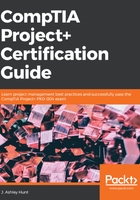
Creating a stakeholder matrix
Now that you have reviewed the different categories of stakeholders, you have to keep them all straight and create a way to keep track of who they are, how they want to be communicated with, what their expectations are, and so on. If only there were a specific document that you could use to do so. Good news, there is! It's called a stakeholder matrix, and while there isn't one way over another to create and use this document, it will go a long way to helping keep everyone straight. Especially if this is a brand-new project and you have never worked with them before.
The first step after identifying your stakeholders is to determine what their level of power/influence and interests are on the project. Be aware that things can change and sometimes change quickly. One stakeholder may be humming along minding their own business and be perfectly happy with weekly updates until something goes sideways on the project that affects them. Now, they are breathing down your neck and demanding daily updates. Trust me, it happens more often than you think.
The right way to engage your stakeholders is to do the best you can to determine their expectations (this week) and then work to meet those expectations. That is akin to having a bunch of preschoolers on the playground and trying to get them to come inside after recess. It's not the easiest task in the world. The stakeholder matrix can help.
In order to put together an effective stakeholder matrix, it's best to actually talk to the individual and ask probing questions, for example, the following:
- How do you prefer to be communicated with: by email, telephone, or meetings?
- How often would you like updates and status reports?
- Would you prefer to pick and choose which meetings to attend? If so, I won't put “required” on the invite.
- What are your needs or concerns about this project?
- What is the planned level of involvement you are expecting?
- What are your expectations of the deliverable, schedule, budget, and so on?
I realize that not everyone is going to be located in your office and some may not even be on the same continent. Understanding their time zones can help enable you to schedule these conversations fairly is important as well. Nobody wants to have a meeting at two in the morning. That makes for very cranky stakeholders, which is the opposite of what we are trying to do.
I find using checklists or interview questions to be the best way to gather information from a variety of people. This keeps the conversation on track and to the point without jumping down any rabbit holes that can sabotage information-gathering. There are a lot of ways to gather information about your stakeholders and no way is really the wrong way, as long as you feel that you have enough information to make the best decisions regarding stakeholder engagement and requirements-collection. The only wrong way is to not do it at all. Therefore, having a comprehensive stakeholder matrix is an excellent tool for stakeholder-management.
Typically (and I say typically because it may be different in your organization), my stakeholder matrix is a collection of information that then allows me the ability to update as needed when individual stakeholder needs on the project change. Trust me, they will change!
Best practice suggests the following headers, but be as creative as needed to engage your own stakeholders:
- Name
- Department
- Contact information
- Time zone (as needed)
- Preferred method of communication
- Communication strategy
- Role or title on the project
- Needs, concerns, and interest regarding the project
- Level of involvement in the project
- Level of influence over the project
For some project managers, this is a mental exercise because they work with the same people all of the time. The only new player may be the customer, and even then, it is a good best practice to document the information, if only as a tangible reminder to engage and communicate in the manner they are expecting. In Chapter 7, Resource Management Planning and Communication Considerations, you will review the creation of a communication plan and different ways to effectively engage your stakeholders.